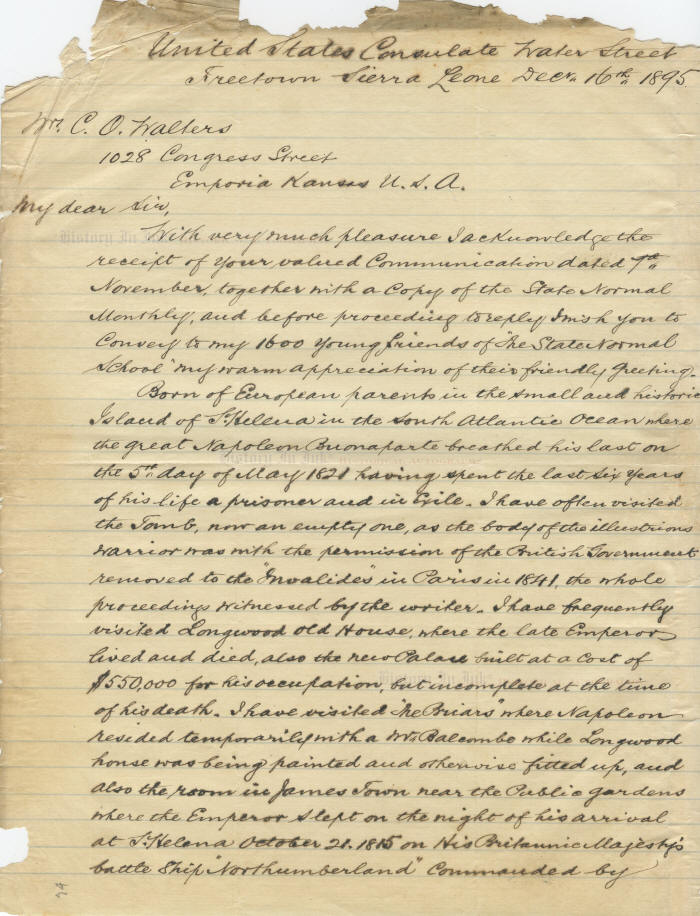1007401
[Napoleon Bonaparte]
Robert P. Pooley
Scroll down to see images of the items below the description
“I have often visited the Tomb, now an empty one,
as the body of the illustrious warrior was . . . removed to the ‘Invalides’ in Paris in 1841,
the whole proceedings witnessed by the writer”
Robert Preston Pooley, 1834–1908. United States Consul at Sierra Leone and St. Helena. Autograph Letter Signed, Rob. P. Pooley / Consul, two pages, 8¼” x 10½”, on plain lined stationery, Freetown, Sierra Leone, December 16, 1895.
Sometimes letters of people who are not themselves particularly historically prominent are nevertheless wonderful, collectable pieces of history. This letter, from a witness to the exhumation of the body of Napoleon Bonaparte, is like that.
Here Pooley, the United States Consul to Sierra Leone, writes of witnessing the ceremony to disinter Napoleon’s body for its return to France in 1840. Napoleon was exiled to St. Helena, an island in the South Atlantic, following his defeat by the British at Waterloo in 1815. When he died in 1821, the British refused to allow the French to reclaim his body. Eventually Britain relented and permitted the French government to return the corpse to France. As he writes in this letter, Pooley, a native of St. Helena, observed the exhumation ceremony. He was a young boy at the time.
Pooley replies to a penmanship student at the State Normal School in Emporia, Kansas, now Emporia State University, who wrote as part of a class project. The penmanship professor had his students solicit handwritten letters from prominent people in the United States and American consular officials overseas for inclusion in albums to be devoted to their handwriting. The students requested handwritten letters containing a reminiscence, a word of advice, or a favorite saying.
In this letter, Pooley writes, in full:
With very much pleasure I acknowledge the receipt of your valued Communication dated 7th November together with a copy of the State Normal Monthly, and before proceeding to reply I wish you to convey to my 1600 young friends of "the State Normal School" my warm appreciation of their friendly greeting.
Born of European parents in the small and historic Island of St. Helena in the South Atlantic Ocean where the great Napoleon Buonaparte breathed his last on the 5th day of May 1821 having spent the last six years of his life a prisoner and in exile, I have often visited the Tomb, now an empty one, as the body of the illustrious warrior was with the permission of the British Government removed to the "Invalides" in Paris in 1841, the whole proceedings witnessed by the writer. I have frequently visited Longwood Old House, where the late Emperor lived and died, also the new Palace built at a cost of $550,000 for his occupation, but incomplete at the time of his death. I have visited "The Briars" where Napoleon resided temporarily with a Mr. Balcombo while Longwood house was being painted and otherwise fitted up, and also the room in James Town near the Public gardens where the Emperor slept on the night of his arrival at St. Helena October 21, 1815 on His Britannic Majesty's battle ship "Northumberland" commanded by Cockburn. It is probably not generally known that this same room had some time previously been occupied by the then Sir Arthur Wellesley, afterwards the Duke of Wellington & Victor of Waterloo, while on his way to England from the East Indies.
At St. Helena I had the honor to represent the U.S. Government for about 10 years as Vice Consul about 2 years of which period as Acting Consul for Germany and Vice Consul for Sweden & Norway. Owing to the collapse of the shipping trade consequent upon the opening of the Suez Canal, I left St. Helena with my family in March 1886 in a sailing ship for New York and settled in Brooklyn, and on September 21, 1891 became a naturalized Citizen of the United States & on November 1st 1893 I was appointed Consul for Sierra Leone.
I have crossed the ocean many times, and visited many places, and in my several vocations as merchant, consul, underwriters' agent &c, experienced the vicissitudes common to most business men, my fortunes now at flow, now at ebb, but throughout my life of 60 years I have ever pinned my faith to the great and all powerful and all loving and merciful Ruler of the Universe, and though at times the clouds were dark & threatening, yet the silver lining appeared in due course and never have I been utterly forsaken; therefore in conclusion, I would heartily commend my 1600 young friends of the State Normal School to the words of the wise King Solomon, "Fear God & keep His commandments, for this is the whole duty of man".
With kind regards & best New Year's greetings to all.
Believe me, yours very sincerely . . . .
Pooley, who was a young boy when Napoleon’s body was exhumed, was a year off on the date. The French returned the body to France in late 1840, not in 1841. We sold a superb letter dated December 29, 1840, two weeks after Napoleon’s funeral in Paris, by Nicholas Jean de Dieu Soult, the Prime Minister of France, thanking François d’Orléans, the son of French King Louis-Philippe who supervised the expedition to return the body to France, for keys to Napoleon’s sarcophagus. Click here to see it.
As he writes, Pooley was born on St. Helena in 1834. He began his consular career in 1856 under George W. Kimball, who was then the United States consul at St. Helena, and served as a clerk, vice consul, acting consul, and eventually as principal consul officer. He was appointed vice consul at St. Helena in 1872 and retired in 1878. He was appointed U.S. consul at Sierra Leone on November 1, 1893, and later was appointed consul at St. Helena again on January 12, 1898. At St. Helena he also represented The Insurance Company, New York, and the Boston Marine Insurance Company in marine insurance matters.
Pooley married Mary Anne Tracy (1839–1934) on St. Helena in 1860. Beginning in 1854, before their marriage, they had 13 children. The first was born when Mary was only about 15 years old and Pooley was about 20.
Pooley has penned this letter in dark brown ink. By the strict grading standards of The Manuscript Society, the letter is in good condition. As mentioned above, the letter was mounted in an album. The second page remains tipped to an album page, but the first page, which was tipped to it at the upper left, was torn away, and the missing upper left corner is still tipped to the second page. The first page has moderate paper loss at the top margin and a small fragment missing at the lower left, but the text of the letter is intact. There is some browning at the top of the first page, but it does not affect the text, either. The heavy ink has bled into the paper, noticeably so at the right margin of the second page, but nevertheless the text is entirely legible. There is a small collector’s pencil notation in the blank area in the lower left corner of the first page.
Unframed.
This item has been sold.








